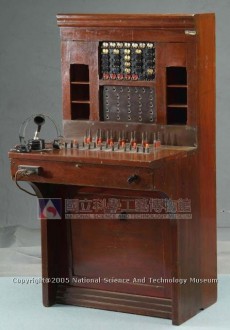|
MANUAL TELEPHONE EXCHANGE (CONSOLE) |

Type: Exchange Equipments
Maker: UNSPECIFIED
Place Made: Unspecified
Date Made: 1960
SIZE: L60* W64* H125cm
Function/Purpose: Since Alexander Graham Bell invented telephones in 1876, distances have been narrowed and closer communication among people has been established. As the need developed from two-way communication to groups, the telephone exchange was quickly invented to help connect every telephone. The earliest invention was the magneto telephone exchange. The second was the common battery telephone exchange. The users of the former had to crank the handle to generate electric current for ringing the bell at the console. When using the latter, a close circuit signal would be sent to the console as the handset was picked up. The operator would begin operation according to the drop or the indicator light. This set is a small-sized single manual telephone exchange (actually it is an exchange console), which was used before 1961.Its receiving unit has been modified into a headset but the microphone is still a separate hand-held type. The communication was made possible by the operator, called OP, who used plug cords to connect /disconnect the caller and the receiver. This simple set, including drops, plug cords, microphones, and a ringing machine can accommodate 20 subscribers (the number of the drops on the panel) and allow 14 subscribers (7 pairs of plug cords) to communicate at the same time. Obviously, there is no comparison between this old model and the modern digital electronic telephone exchange which can accommodate more than a hundred thousand users.
Characteristics: This set was originally made just for single operators. As the number of subscriber increases, more sets can be connected in parallel and be integrated into a huge system for multi-operators, and the drops (which need to be manually restored) can also be replaced by indication lights. Presently, the military telephone exchange is temporarily preserved at its original site, Taipei’s South First Branch. It is a magnificent example of this kind of telephone exchange for multi-operators.
Text and images are provided by National Science and Technology Museum
|

